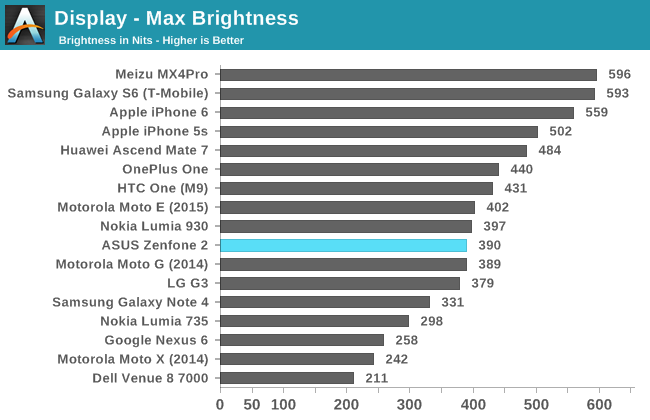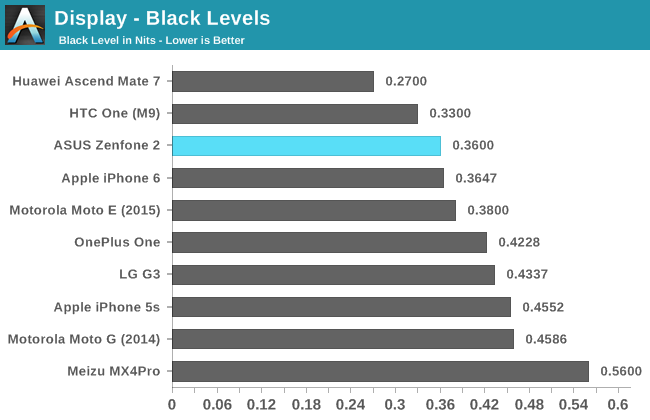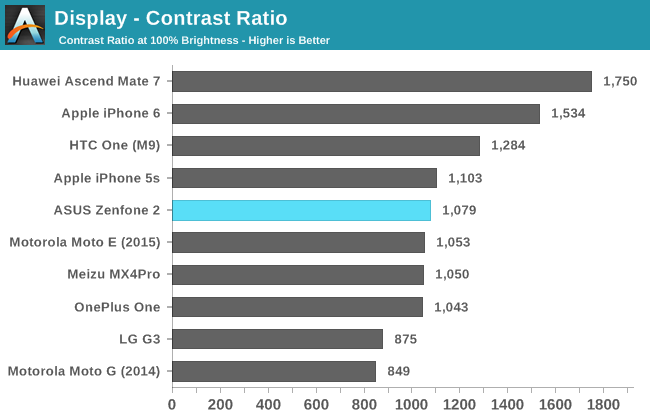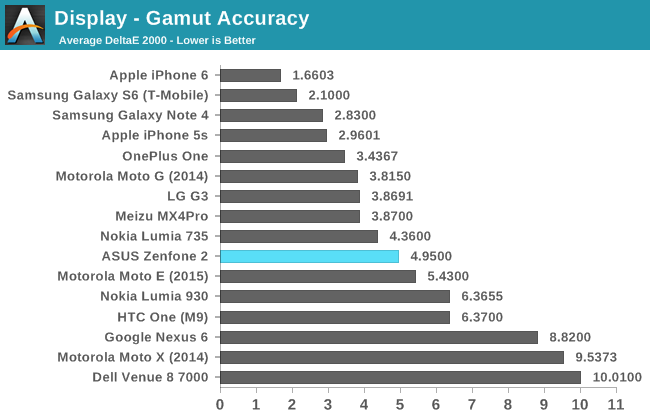The ASUS ZenFone 2 Preview
by Brandon Chester on May 18, 2015 2:00 PM ESTDisplay
I thought it would be important to give potential buyers some idea of how good the display is on the ZenFone 2. On paper it looks very good, as it's a 5.5" 1920x1080 IPS display. The pixel density isn't as high as the latest generation of 2560x1440 panels, but I find that with an RGB stripe panel the difference between 1920x1080 and 2560x1440 is minimal even at 5.5".


The ZenFone 2 appears to be off to a good start. Black levels are very low among our LCDs, and the max brightness is somewhat low but not terrible by any means. I never had any issues when using the ZenFone 2 outside, although it was definitely not as comfortable as the Galaxy S6.

The slightly low max brightness and above average black level results put the ZenFone 2 right in the middle of our LCD devices when it comes to contrast ratio.
Unfortunately, these numbers are somewhat misleading. This is because the ZenFone 2 makes extremely heavy use of dynamic contrast and contect adaptive backlighting. I have never used another device with such dramatic shifts in backlight power. The best example I've found is when switching from an all black to all white screen at max brightness. While this is obviously an extreme case, it illustrates the behavior that is occuring very well. At the moment you switch to white, the brightness of the display is around 170 nits. Over the next few seconds, that brightness rapidly increases to the 390 nits you see in the results above. This is an enormous jump in brightness, and it's very easy to see with your own eyes.
One last thing I'd like to note about the brightness is that the 100% setting on the built in brightness slider is not actually the max brightness that the display is capable of. The max you can achieve using the slider in the Settings app is 319 nits, which is around 82% of the 390 nit result you can get using applications like Brightness Adjuster from Google Play.

The gamut results are unfortunately not as good as what we've seen from the latest generation of smartphones. The DeltaE for red, blue, and magenta are all just over three, while the remaining three colors are around five. The high error in white also contributes to the higher than optimal overall error.
The complete review of the ZenFone 2 should be posted in the near future, and it will include the remainder of our display workflow. The heavy use of CABC and dynamic contrast has a large impact on the display's performance in some of our tests, and so I'll also be elaborating on where and why that occurs, and what it means for the user. For anyone who really wants to order the ZenFone 2 now, I'll conclude by saying that it's definitely not perfect, but it's still a good display. I think it's by far the nicest one you'll find on a phone that starts at $199 purely because of its resolution.











139 Comments
View All Comments
Daniel Egger - Monday, May 18, 2015 - link
A BIOS not needed to run Windows (neither 8.1 and certainly not Windows Phone) same as for Linux -- here in the incarnation of Android. I don't see anything that would prevent Moorefield (in comparison to say Bay Trail or Cherry Trail) from running Windows as only TDP and GPU are different but there're Windows drivers for PowerVR available so why not...danbob999 - Monday, May 18, 2015 - link
BIOS is not needed (UEFI can replace it) but I guess this phone has neither BIOS and UEFI, and probably lacks a bootloader capable of booting regular Windows.Daniel Egger - Tuesday, May 19, 2015 - link
The question was not whether the installed bootloader was capable of starting Windows but whether the CPU would allow running Windows and for me that's a clear yes.ZeDestructor - Tuesday, May 19, 2015 - link
Hmm.. Now I'm wondering if you could hack together a chainloader or shim of sorts from the virtual BIOS/EFI in open-vm-tools...More interesting would be if it supports stuff like ACPI...
Daniel Egger - Tuesday, May 19, 2015 - link
Not sure that's even necessary. I see two possible approaches:- Poach the bootloader from one of the existing Windows 8.1 Tablets
- Run a hypervisor and start Windows from that
messyOwl - Tuesday, May 19, 2015 - link
Pretty sure this chip is targeted at mobile and android.The OS on the phone is 32 bit. The OS on the Zenfone 2 supports x86, armeabi-v7a, and armeabi instructions which leads me to conclude this intel chip supports these instructions (or emulates them?).
jann5s - Tuesday, May 19, 2015 - link
I meant x86,der - Monday, May 18, 2015 - link
Hi. Its nice to see a preview of it. 3rd commentoCajunArson - Monday, May 18, 2015 - link
OK, could you or somebody knowledgeable PLEASE answer the following seemingly-simple question: Will it work with Verizon??I just saw the live-stream of that huge dog and pony show that revealed nothing new about the phone (which has been on-sale overseas for several months) and they can't even be bothered to answer a rudimentary question like... does the phone actually work with different networks! Aggh!
stab244 - Monday, May 18, 2015 - link
No. It doesn't have the CDMA radios needed to work. Very rarely will an unlocked phone work with Verizon.